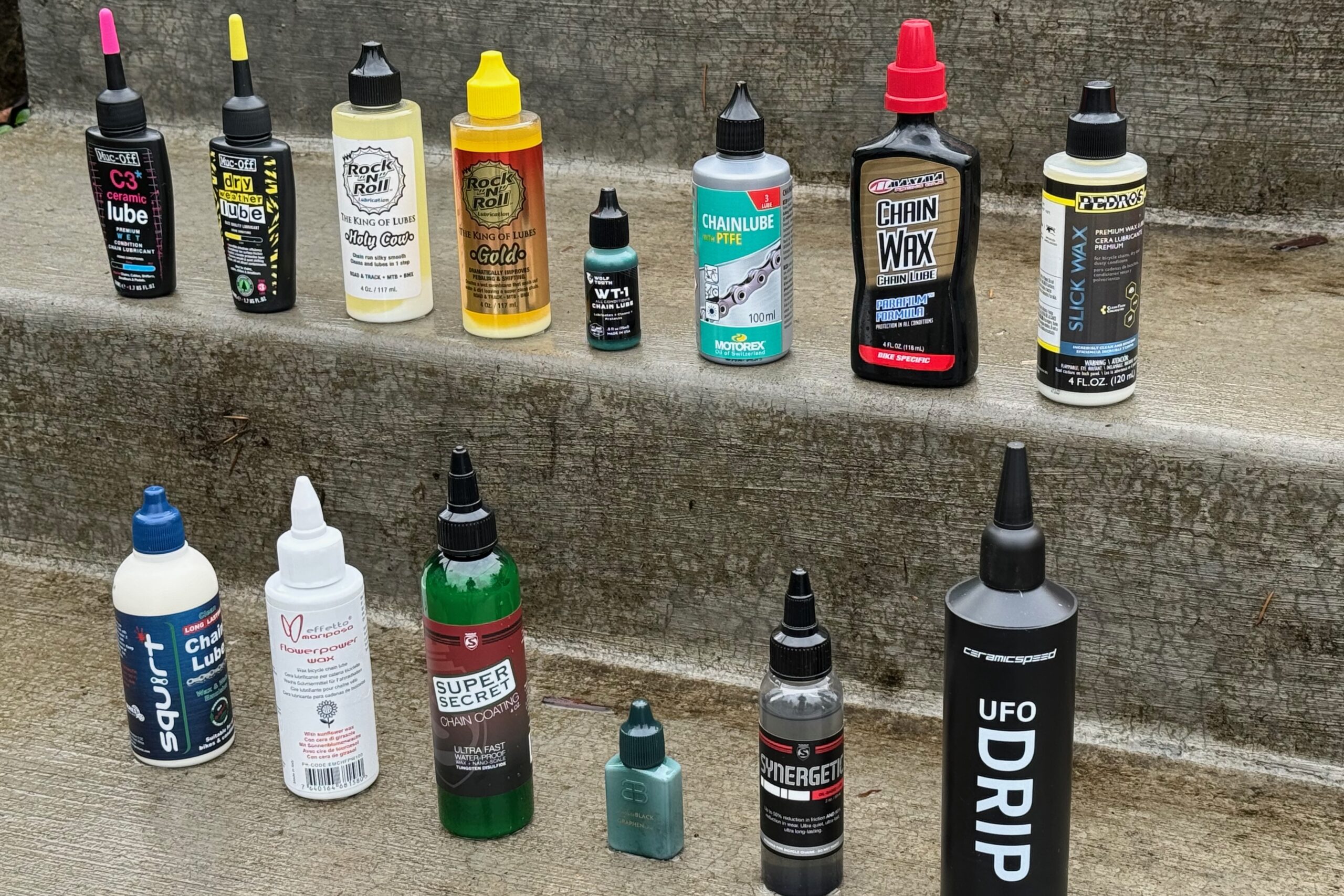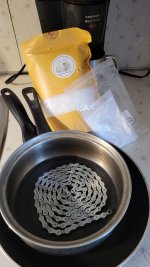smorgasbord
Well-Known Member
- Region
- USA
Chain lubes are among the contentious discussions in the biking world, and EBR is no exception.
Some here may know of the Australian company ZeroFrictionCycling and its extensive testing efforts over the years. Their testing protocol is well-documented, uses a motor-driven actual bicycle drivetrain.
It's a 5-stage test:
Block 1 - Clean environment for 1,000 kms. Measure wear then proceed to
Block 2 - Dusty/Sandy environment for 1,000 kms. Measure wear then proceed to
Block 3- Clean environment for 1,000 kms. Measure wear then proceed to
Block 4 - Wet environment for 1,000 kms. Measure wear then proceed to
Block 5 - Clean environment for 1,000 kms. Measure wear then proceed to
Block 6 -Extreme contamination for 1,000 kms. Measure wear.
Chains are not cleaned once the test starts. Re-lubing is done per manufacturer's recommendations - doubled during the wet and extreme tests.
The full testing protocol is documented here: https://zerofrictioncycling.com.au/...01/ZFC-Test-protocol-Full-Brief-v3-Jan-25.pdf
The results are on the web here: https://zerofrictioncycling.com.au/lubetesting/
And the full Excel document can be downloaded here: https://zerofrictioncycling.com.au/...0/Test-Main-DATA-Oct-25-website-upload-1.xlsx
Interestingly, BikeRumor.com has had articles on best bike lubes. Here's a video of the ZeroFrictionCycling guy reviewing that review:
He mostly agrees with the top picks, but points out, for instance, that Rock N’ Roll Gold is an "old" formula that was great in its day, but new formulations from other companies over the years have since have surpassed it. So, the lube that was better than many of its peers 15 years ago is now just middle of the pack.
ZFC has also done a single application longetivity test, which may also be of interest to people who don't want to take the time to re-lube frequently.
Here's a link to BikeRumor's lube review:

 bikerumor.com
bikerumor.com
Enjoy
Some here may know of the Australian company ZeroFrictionCycling and its extensive testing efforts over the years. Their testing protocol is well-documented, uses a motor-driven actual bicycle drivetrain.
It's a 5-stage test:
Block 1 - Clean environment for 1,000 kms. Measure wear then proceed to
Block 2 - Dusty/Sandy environment for 1,000 kms. Measure wear then proceed to
Block 3- Clean environment for 1,000 kms. Measure wear then proceed to
Block 4 - Wet environment for 1,000 kms. Measure wear then proceed to
Block 5 - Clean environment for 1,000 kms. Measure wear then proceed to
Block 6 -Extreme contamination for 1,000 kms. Measure wear.
Chains are not cleaned once the test starts. Re-lubing is done per manufacturer's recommendations - doubled during the wet and extreme tests.
The full testing protocol is documented here: https://zerofrictioncycling.com.au/...01/ZFC-Test-protocol-Full-Brief-v3-Jan-25.pdf
The results are on the web here: https://zerofrictioncycling.com.au/lubetesting/
And the full Excel document can be downloaded here: https://zerofrictioncycling.com.au/...0/Test-Main-DATA-Oct-25-website-upload-1.xlsx
Interestingly, BikeRumor.com has had articles on best bike lubes. Here's a video of the ZeroFrictionCycling guy reviewing that review:
He mostly agrees with the top picks, but points out, for instance, that Rock N’ Roll Gold is an "old" formula that was great in its day, but new formulations from other companies over the years have since have surpassed it. So, the lube that was better than many of its peers 15 years ago is now just middle of the pack.
| The table shows the wear recorded across the main test (cumulative - each blocks wear added to all previous wear). |
| For most data / cost comparisons I use the first 5000km only, excluding harsh block 6, as most lubircants have failed long before, and I am using heavily extrapolated data to fill. |
| The main test up to the end of Block 5 (5000km of testing including a dry contamination block and a wet contamination block) - is an overall fairly tough test. |
| A lubricant with a result of 1.0 (one chain worn to the recommended chain wear replacement mark of 0.5% elongation wear) for Block 5 is a high performing lubricant |
| For MOST cyclists - especially predominantely dry conditions road cycling - you should also expect to attain at least 5000km to a 0.5% wear mark for that lubricant. |
| IF you ride predominantly offroad - you should refer to the individual block by block data table (below the cumulative wear table) to select a lubricant that performs well |
| in offroad conditions (gravel / mtb). Many wet lubricants especially become very abrasive very quickly when exposed to the world of dirt and dust. |
| IF you ride predominantly or frequently in wet condtions / harsh wet conditions - you should refer to the block by block data table (below cumulative wear table) to select |
| a lubricant that performs well in those conditions. |
ZFC has also done a single application longetivity test, which may also be of interest to people who don't want to take the time to re-lube frequently.
Here's a link to BikeRumor's lube review:

The Best Bike Chain Lubes of 2025
We tested 16 of the best bike chain lubes on the market to help you keep your bike running smoothly and quietly and extend the life of your drivetrain.
Enjoy
